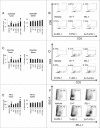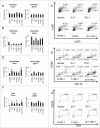Combined treatment with dabrafenib and trametinib with immune-stimulating antibodies for BRAF mutant melanoma
- PMID: 27622011
- PMCID: PMC5006894
- DOI: 10.1080/2162402X.2015.1052212
Combined treatment with dabrafenib and trametinib with immune-stimulating antibodies for BRAF mutant melanoma
Abstract
The combination of targeted therapy with BRAF and MEK inhibitors has become the standard of care in patients with BRAF (V600E) mutant melanoma, but responses are not durable. In addition, the impressive clinical benefits with anti-PD-1 and anti-PD-L1 antibodies (Ab) in patients with heavily pretreated metastatic melanoma and the synergistic effect of dabrafenib, trametinib and anti-PD-1 compared with single therapy alone groups support the idea that combining dabrafenib, trametinib and immunotherapy based on PD-1 blockade could be an interesting approach in the treatment of metastatic melanoma. With our mouse model of syngeneic BRAF (V600E) driven melanoma (SM1), we tested whether the addition of an immunostimulatory Ab targeting CD137 (4-1BB) and/or CD134 (OX40) would enhance the antitumor effect of dabrafenib, trametinib and anti-PD-1 or anti-PD-L1 therapy. In vitro studies showed that the combination group of dabrafenib, trametinib and anti-PD-1 increases CD8(+) tumor infiltrating lymphocytes (TILs), as well as CD4(+) T cells and tumor-associated macrophages (TAMs). An upregulation of PD-L1 was observed in the combination of dabrafenib, trametinib and anti-PD-1 therapy. Combination of dabrafenib, trametinib and anti-PD-1, with either anti-CD137 or anti-CD134, showed a superior antitumor effect, but the five-agent combination was not superior to the four-agent combinations. In conclusion, the combination of dabrafenib, trametinib, anti-PD1 or anti-PD-L1 therapy results in robust antitumor activity, which is further improved by adding the immune-stimulating Ab anti-CD137 or anti-CD134. Our findings support the testing of these combinations in patients with BRAF (V600E) mutant metastatic melanoma.
Keywords: PD-1; checkpoint blockade; immunotherapy; melanoma; targeted therapy.
Figures




Similar articles
-
Improved antitumor activity of immunotherapy with BRAF and MEK inhibitors in BRAF(V600E) melanoma.Sci Transl Med. 2015 Mar 18;7(279):279ra41. doi: 10.1126/scitranslmed.aaa4691. Sci Transl Med. 2015. PMID: 25787767 Free PMC article.
-
The BRAF and MEK Inhibitors Dabrafenib and Trametinib: Effects on Immune Function and in Combination with Immunomodulatory Antibodies Targeting PD-1, PD-L1, and CTLA-4.Clin Cancer Res. 2015 Apr 1;21(7):1639-51. doi: 10.1158/1078-0432.CCR-14-2339. Epub 2015 Jan 14. Clin Cancer Res. 2015. PMID: 25589619
-
New developments in the treatment of metastatic melanoma - role of dabrafenib-trametinib combination therapy.Drug Healthc Patient Saf. 2014 Jun 24;6:77-88. doi: 10.2147/DHPS.S39568. eCollection 2014. Drug Healthc Patient Saf. 2014. PMID: 25018652 Free PMC article. Review.
-
Trametinib: a MEK inhibitor for management of metastatic melanoma.Onco Targets Ther. 2015 Aug 25;8:2251-9. doi: 10.2147/OTT.S72951. eCollection 2015. Onco Targets Ther. 2015. PMID: 26347206 Free PMC article. Review.
-
Adverse Event Management in Patients with BRAF V600E-Mutant Non-Small Cell Lung Cancer Treated with Dabrafenib plus Trametinib.Oncologist. 2019 Jul;24(7):963-972. doi: 10.1634/theoncologist.2018-0296. Epub 2018 Dec 31. Oncologist. 2019. PMID: 30598499 Free PMC article.
Cited by
-
Olaparib and Pembrolizumab Treatment for BRCA1-Mutated and PD-L1-Positive Intrahepatic Cholangiocarcinoma Recurrence and Metastasis: A Case Report.Onco Targets Ther. 2020 Jul 1;13:6385-6391. doi: 10.2147/OTT.S250454. eCollection 2020. Onco Targets Ther. 2020. PMID: 32753881 Free PMC article.
-
Combining targeted therapy with immunotherapy. Can 1+1 equal more than 2?Semin Immunol. 2016 Feb;28(1):73-80. doi: 10.1016/j.smim.2016.01.001. Epub 2016 Feb 6. Semin Immunol. 2016. PMID: 26861544 Free PMC article. Review.
-
The role of CRAF in cancer progression: from molecular mechanisms to precision therapies.Nat Rev Cancer. 2024 Feb;24(2):105-122. doi: 10.1038/s41568-023-00650-x. Epub 2024 Jan 9. Nat Rev Cancer. 2024. PMID: 38195917 Review.
-
Gut Microbiota and Therapy in Metastatic Melanoma: Focus on MAPK Pathway Inhibition.Int J Mol Sci. 2022 Oct 9;23(19):11990. doi: 10.3390/ijms231911990. Int J Mol Sci. 2022. PMID: 36233289 Free PMC article. Review.
-
Advanced Acral Melanoma Therapies: Current Status and Future Directions.Curr Treat Options Oncol. 2022 Oct;23(10):1405-1427. doi: 10.1007/s11864-022-01007-6. Epub 2022 Sep 20. Curr Treat Options Oncol. 2022. PMID: 36125617 Free PMC article. Review.
References
-
- Brahmer JR, Tykodi SS, Chow LQ, Hwu WJ, Topalian SL, Hwu P, Drake CG, Camacho LH, Kauh J, Odunsi K et al.. Safety and activity of anti-PD-L1 antibody in patients with advanced cancer. N Engl J Med 2012; 366:2455-65; PMID:22658128; http://dx.doi.org/10.1056/NEJMoa1200694 - DOI - PMC - PubMed
-
- Hamid O, Robert C, Daud A, Hodi FS, Hwu WJ, Kefford R, Wolchok JD, Hersey P, Joseph RW, Weber JS et al.. Safety and tumor responses with lambrolizumab (anti-PD-1) in melanoma. N Engl J Med 2013; 369:134-44; PMID:23724846; http://dx.doi.org/10.1056/NEJMoa1305133 - DOI - PMC - PubMed
-
- Hodi FS, O'Day SJ, McDermott DF, Weber RW, Sosman JA, Haanen JB, Gonzalez R, Robert C, Schadendorf D, Hassel JC et al.. Improved survival with ipilimumab in patients with metastatic melanoma. N Engl J Med 2010; 363:711-23; PMID:20525992; http://dx.doi.org/10.1056/NEJMoa1003466 - DOI - PMC - PubMed
-
- Robert C, Thomas L, Bondarenko I, O'Day S, Weber J, Garbe C, Lebbe C, Baurain JF, Testori A, Grob JJ et al.. Ipilimumab plus dacarbazine for previously untreated metastatic melanoma. N Engl J Med 2011; 364:2517-26; PMID:21639810; http://dx.doi.org/10.1056/NEJMoa1104621 - DOI - PubMed
-
- Topalian SL, Hodi FS, Brahmer JR, Gettinger SN, Smith DC, McDermott DF, Powderly JD, Carvajal RD, Sosman JA, Atkins MB et al.. Safety, activity, and immune correlates of anti-PD-1 antibody in cancer. N Engl J Med 2012; 366:2443-54; PMID:22658127; http://dx.doi.org/10.1056/NEJMoa1200690 - DOI - PMC - PubMed
Publication types
Grants and funding
LinkOut - more resources
Full Text Sources
Molecular Biology Databases
Research Materials
